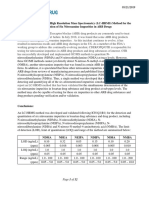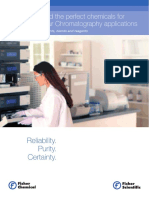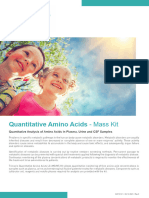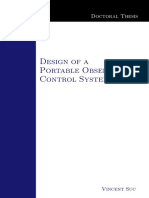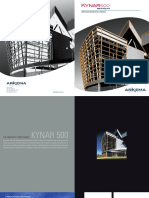Application Note: In-Process Control of Ergoline Psychedelics During Chemical Synthesis by HPTLC
Application Note: In-Process Control of Ergoline Psychedelics During Chemical Synthesis by HPTLC
Uploaded by
Mauro MarafonCopyright:
Available Formats
Application Note: In-Process Control of Ergoline Psychedelics During Chemical Synthesis by HPTLC
Application Note: In-Process Control of Ergoline Psychedelics During Chemical Synthesis by HPTLC
Uploaded by
Mauro MarafonOriginal Title
Copyright
Available Formats
Share this document
Did you find this document useful?
Is this content inappropriate?
Copyright:
Available Formats
Application Note: In-Process Control of Ergoline Psychedelics During Chemical Synthesis by HPTLC
Application Note: In-Process Control of Ergoline Psychedelics During Chemical Synthesis by HPTLC
Uploaded by
Mauro MarafonCopyright:
Available Formats
APPLICATION NOTE
In-process control of ergoline psychedelics during
chemical synthesis by HPTLC A-99.1
Keywords
LSD, LSP, LSM, LSZ, mass detection, in-process control, quality control,
HPTLC-MS, scanning densitometry
Introduction
TLC is a simple and convenient tool for monitoring classical organic
syntheses. Standardized HPTLC may additionally provide reliable analytical
endpoints and significantly improved separation. Structure confirmation can
be achieved with HPTLC-MS hyphenation. In addition, HPTLC can be used
as a technique complementary to existing HPLC methods for ensuring a
product of high purity.
Scope
This method is suitable for identification of synthesis products. The CAMAG
TLC-MS Interface 2 is used to directly elute target zones from the HPTLC
plate into the Waters ACQUITY QDa® for mass detection. A second
confirmation can be achieved by recording the UV spectra with the TLC
scanner. A fast way for in-process and quality control during synthesis of
ergoline psychedelics is shown below.
Synthesis of ergoline psychedelics
In a first step lysergic acid (LysS) is produced from ergotamine as starting
material. Then the formation of different amides takes place, with LSD, LSZ,
LSP, and LSM as finished products.
LysS is the starting material for the synthesis of LSD, LSZ, LSP, and
LSM; different side chains are highlighted in red
NOTE: The presented results are to be regarded as examples only!
Please contact CAMAG for more application notes and products!
www.camag.com 1 of 4 02/2016
APPLICATION NOTE
Required or recommended devices
Automatic TLC Sampler 4 or Linomat 5, Automatic Developing Chamber ADC
2, Immersion Device 3, TLC Visualizer, visionCATS software, TLC Scanner,
TLC-MS Interface 2, Waters ACQUITY QDa Detector (Performance),
Empower® or MassLynx® software, optional: UV Cabinet
Sample
Samples from different synthesis steps are applied directly onto HPTLC
plates without further preparation. Depending on the process step the applied
volume can vary as well as the solvent (in most cases dichloromethane
and/or methanol). The purified synthesis products are dissolved in methanol
(1 mg/mL). Samples and purified synthesis products were provided by
Lipomed AG (Arlesheim, Switzerland).
Standards
Methanolic solution of LSD (0.1 mg/mL). Standard was provided by Lipomed
AG (Arlesheim, Switzerland).
Chromatography
Stationary phase: HPTLC Si 60 F254, 20 x 10 cm (Merck).
Sample application: Bandwise application with ATS 4 or Linomat 5, 15 tracks, band length 8 mm,
track distance 11.4 mm, distance from left edge 20 mm, distance from lower
edge 8 mm, application volume between 0.5 und 15 μL for sample solutions,
1 μL for dissolved purified synthesis products and 8 μL for the standard
solution.
Developing solvent: Dichloromethane – methanol – trimethylamine 9:1:0.002 (v/v/v)
In the case of LSZ: dichloromethane – isopropanol – triethylamine 9:1:0.002
(v/v/v)
Development: In the ADC 2 with chamber saturation (with filter paper) 20 min and after
conditioning at 33% relative humidity for 10 min using a saturated solution of
magnesium chloride.
Developing distance: 70 mm (from the lower edge)
Plate drying: Drying 5 min in the ADC 2
Documentation: With the TLC Visualizer under UV 254 and UV 366 nm
Densitometry: Densitometric analyses are performed at 254 nm (absorbance) and
366/>400 nm (fluorescence), slit dimension 5.0 x 0.2 mm, scanning speed
20 mm/s, spectra recording 200 to 500 nm
MS confirmation: The zones to be eluted are marked with a soft pencil under UV 254 nm and/or
UV 366 using the UV cabinet or TLC Visualizer.
Target zones are directly eluted using the TLC-MS Interface 2 with oval
elution head into the ACQUITY QDa Detector at a flow rate of 0.5 mL/min with
methanol (with 0.1% formic acid) – water 90:10 (v/v). For a full scan spectrum
it is recommended to first elute a blank, which can be subtracted from the
spectra of the target zones. For confirmation of substances between 50 and
500 ng per zone are required.
NOTE: The presented results are to be regarded as examples only!
Please contact CAMAG for more application notes and products!
www.camag.com 2 of 4 02/2016
APPLICATION NOTE
+
MS parameter: The ACQUITY QDa Detector is operated in ESI mode using default
parameters. The ESI capillary is set to 0.8 kV, cone voltage to 15 V, and
desolvation temperature at 600 °C. A full scan mass spectrum between m/z
50 and 650 is acquired at a sampling rate of 10.0 points/sec (continuum).
Data processing and evaluation of mass spectra are performed with
Empower. For routine use in quality control Single Ion Recording (SIR) can be
performed.
Results
System Suitability Test (SST):
LSD shows a quenching zone (under UV 254 nm) and a blue fluorescent zone (under UV 366 nm) at
RF ~ 0.43
a) In-process control during synthesis of LSP:
Fig. 1 Chromatograms under UV 254 nm und 366 nm that show the different synthesis steps, including the
purification, 1: LSD as reference, 2: Hydrolysis of lysergic acid from ergotamin, 3: purified lysergic acid (starting
material for the chemical synthesis), 4: crude synthesis product (LSP and side products), 5: Column purification,
6: second column purification, 7: purified LSP; UV spectrum and densitogram of LSP 366/>400 nm (fluorescence)
b) Confirmation of the purified synthesis products:
Fig. 2 HPTLC-MS mass spectra of LSD, LSP, LSM, and LSD, displayed range m/z 250 to 380 and HPTLC Image
Comparison of the purified synthesis products under UV 366 nm (left; tracks 1: LSD as reference; 2: purified LSP,
3: purified LSM, 4: purified LSZ(two product zones due to the formation of the isomers [1]))
NOTE: The presented results are to be regarded as examples only!
Please contact CAMAG for more application notes and products!
www.camag.com 3 of 4 02/2016
APPLICATION NOTE
Acknowledgment
This work was done at Lipomed AG (Arlesheim, Switzerland). We are grateful to Dr. Matthias Grill for
the excellent collaboration.
Literature
[1] David E. Nichols et al., J Med Chem 45 (2002) 4344
[2] Alexander Shulgin et al., TIHKAL: The Continuation, 1997
[3] Matthias Grill and Melanie Broszat, CAMAG Bibliogr Service CBS 115 (2015) 11-12
NOTE: The presented results are to be regarded as examples only!
Please contact CAMAG for more application notes and products!
www.camag.com 4 of 4 02/2016
You might also like
- Digital Infrared Photography Manual PDFDocument352 pagesDigital Infrared Photography Manual PDFMauro MarafonNo ratings yet
- Pc300lc 6 LCDocument786 pagesPc300lc 6 LCOscar Trigo100% (2)
- Encyclopedia of Inorganic Chemistry PDFDocument191 pagesEncyclopedia of Inorganic Chemistry PDFDan Bo100% (2)
- I-1c FarmMech 20-60Document41 pagesI-1c FarmMech 20-60SannyBombeoJomoc50% (2)
- Detection of Steroids and Sarms: Application NoteDocument5 pagesDetection of Steroids and Sarms: Application NoteMauro MarafonNo ratings yet
- Camag App Note SuppliedDocument8 pagesCamag App Note SuppliedMauro MarafonNo ratings yet
- Confirming The Presence of Cannabinoids In: Cannabis Sativa by HPTLC-MSDocument3 pagesConfirming The Presence of Cannabinoids In: Cannabis Sativa by HPTLC-MSMauro MarafonNo ratings yet
- Detection of UV Filters in Cosmetic Products (Sunscreen) by HPTLC and Confirmation by Hptlc-MsDocument3 pagesDetection of UV Filters in Cosmetic Products (Sunscreen) by HPTLC and Confirmation by Hptlc-MsMauro MarafonNo ratings yet
- Detection of Sibutramine in Slimming Products by HPTLC and Confirmation by HPTLC-MSDocument3 pagesDetection of Sibutramine in Slimming Products by HPTLC and Confirmation by HPTLC-MSIsmi HarumainiNo ratings yet
- HPLCDocument5 pagesHPLCThành BíchNo ratings yet
- HPTLCDocument26 pagesHPTLCBhavik NagdaNo ratings yet
- Phyto Chemical Finger Printing - Copy-1Document44 pagesPhyto Chemical Finger Printing - Copy-1Sᴀᴛʜʏᴀ Mᴏᴏʀᴛʜʏ.KNo ratings yet
- HPLC Surfactant AlalysisDocument6 pagesHPLC Surfactant AlalysisDavid Tex LoberNo ratings yet
- Quantification of Nicotine in Liquids For Electronic CigarettesDocument4 pagesQuantification of Nicotine in Liquids For Electronic CigarettesMauro MarafonNo ratings yet
- Quantitation of 764 Pesticide Residues in Tomato by LC MS 1682640663Document8 pagesQuantitation of 764 Pesticide Residues in Tomato by LC MS 1682640663Thaís FerreiraNo ratings yet
- FY20-106-DPA-S - LC-ESI-HRMS Method For Detection of Nitrosamine Impurities in Metformin - For Sharing FINAL 6-3-20Document11 pagesFY20-106-DPA-S - LC-ESI-HRMS Method For Detection of Nitrosamine Impurities in Metformin - For Sharing FINAL 6-3-20Erdem SavasNo ratings yet
- ZZ1-HPLC 2018-Adsn PDFDocument334 pagesZZ1-HPLC 2018-Adsn PDFSantya Nuhaida Lakshita100% (1)
- APP Rapid LCMSMS Analysis of Phthalates 012766A 01Document3 pagesAPP Rapid LCMSMS Analysis of Phthalates 012766A 01RocketManNo ratings yet
- CVUA Karlsruhe Method Based On UHPLC-APCI-MS - MSDocument7 pagesCVUA Karlsruhe Method Based On UHPLC-APCI-MS - MSDip DuttaNo ratings yet
- Determination of Benzimidazole Fungicides in Apple Juice by Sampliq Polymer SCX Solid-Phase Extraction With High-Performance Liquid ChromatographyDocument6 pagesDetermination of Benzimidazole Fungicides in Apple Juice by Sampliq Polymer SCX Solid-Phase Extraction With High-Performance Liquid ChromatographyDesislav DonchevNo ratings yet
- Kantor: JLN Mangga III Blok C12-13, Daya-Makassar, 90241Document42 pagesKantor: JLN Mangga III Blok C12-13, Daya-Makassar, 90241ddtank sandyNo ratings yet
- HPTLC Method For The Simultaneous Estimation of Oxyclozanide and Levamisole Hydrochloride in Tablet Dosage FormDocument6 pagesHPTLC Method For The Simultaneous Estimation of Oxyclozanide and Levamisole Hydrochloride in Tablet Dosage FormtuyetbangNo ratings yet
- CRLFV Multiresidue MethodsDocument20 pagesCRLFV Multiresidue Methods829255No ratings yet
- AN40986 Trace Contaminant Analysis in Brine Using An Icap 6000 Series Duo IcpDocument6 pagesAN40986 Trace Contaminant Analysis in Brine Using An Icap 6000 Series Duo IcpNitisha RathoreNo ratings yet
- Maldi TLCDocument6 pagesMaldi TLCcyannNo ratings yet
- FDA-LC-HRMS MethodDocument12 pagesFDA-LC-HRMS MethodHimikaNo ratings yet
- Chemicals For ChromatographyDocument16 pagesChemicals For ChromatographyHikaru Graeme Enoki-JolliffeNo ratings yet
- HPMC Pittcon 2008Document1 pageHPMC Pittcon 2008Sonet SahaNo ratings yet
- CRLFV Multiresidue MethodsDocument20 pagesCRLFV Multiresidue MethodsCristian CarrascoNo ratings yet
- Merck TLC-brochureDocument32 pagesMerck TLC-brochureJózsef PasinszkiNo ratings yet
- 1 s2.0 S0021967304010830 Main PDFDocument5 pages1 s2.0 S0021967304010830 Main PDF22690552 Alison Paulina Carmona AguilarNo ratings yet
- Determinación COVs en Aguas Por CG-MS HeadspaceDocument6 pagesDeterminación COVs en Aguas Por CG-MS HeadspaceCristian CarrascoNo ratings yet
- HPTLC: Factors Influencing The TLC / HPTLC Separation and Resolution of SpotsDocument8 pagesHPTLC: Factors Influencing The TLC / HPTLC Separation and Resolution of Spots0921pyNo ratings yet
- Validación Métodos AnaliticosDocument12 pagesValidación Métodos AnaliticosJuan Gabriel GualterosNo ratings yet
- FY20-006-DPA-S - LC-MSMS Method For The Determination of NDMA in Ranitidine Dak PDFDocument7 pagesFY20-006-DPA-S - LC-MSMS Method For The Determination of NDMA in Ranitidine Dak PDFTony Cogliano Allechi SpencerNo ratings yet
- Metodo HmiDocument9 pagesMetodo HmivraulcondoriNo ratings yet
- 5991-hplc 1260 Mid DistDocument6 pages5991-hplc 1260 Mid Distمحمد محمودNo ratings yet
- Agilent Food Testing: SolutionsDocument36 pagesAgilent Food Testing: Solutionsnha vũNo ratings yet
- Analysis of Multiresidue Pesticides in SalmonDocument8 pagesAnalysis of Multiresidue Pesticides in SalmonpeterppsNo ratings yet
- 5991-0350EN Water BrochureDocument28 pages5991-0350EN Water Brochurepeeping.dogNo ratings yet
- 10.1007@s00764 020 00042 ZDocument10 pages10.1007@s00764 020 00042 ZCon Bò Sữa Thất TìnhNo ratings yet
- Nirav M.SC Molecular ScienceDocument26 pagesNirav M.SC Molecular Sciencepatelnirav121983No ratings yet
- Liu 1999Document7 pagesLiu 1999barti koksNo ratings yet
- Compilation of EPA's Sampling and Analysis MethodsDocument214 pagesCompilation of EPA's Sampling and Analysis Methodspiero astiNo ratings yet
- Arnhard 2012Document14 pagesArnhard 2012malwanafhc.adNo ratings yet
- An Pesticide Residue Tomato 6546 LC Qtof 1290 Infinity II 5994 6799en AgilentDocument8 pagesAn Pesticide Residue Tomato 6546 LC Qtof 1290 Infinity II 5994 6799en Agilentn.anbarasan2No ratings yet
- Different Analytical Methods For The Determination of Metronidazole - A ReviewDocument5 pagesDifferent Analytical Methods For The Determination of Metronidazole - A ReviewIjrei JournalNo ratings yet
- Apa 5Document24 pagesApa 5athira30janNo ratings yet
- AnalysisDocument30 pagesAnalysisSai SaiNo ratings yet
- Thin Layer ChromatographyDocument3 pagesThin Layer Chromatographykazyhabib.dgdaNo ratings yet
- Rapid Analysis of Genotoxic Nitrosamines by HPLC MS MSDocument3 pagesRapid Analysis of Genotoxic Nitrosamines by HPLC MS MSMarcio SchiavelliNo ratings yet
- Oat HPLC 4Document11 pagesOat HPLC 4mahatir muhammadNo ratings yet
- Practical 3: Enzymes Assay of Lactate Dehydrogenase ActivityDocument7 pagesPractical 3: Enzymes Assay of Lactate Dehydrogenase ActivitymismaelNo ratings yet
- 7 AmmoniaDocument7 pages7 AmmoniaAzhar Clinical Laboratory TubeNo ratings yet
- Lab21 Met Voc ClaytonDocument12 pagesLab21 Met Voc ClaytonTrầnXuânSơnNo ratings yet
- Cleaning Level Acceptance Criteria For Nabumetone ResiduesDocument6 pagesCleaning Level Acceptance Criteria For Nabumetone ResiduesOdunlamiNo ratings yet
- Manuel LCMS v2.1 Mai 2009.fr - enDocument18 pagesManuel LCMS v2.1 Mai 2009.fr - enjegangchemistigcarNo ratings yet
- Fosfatos en Agua de MarDocument26 pagesFosfatos en Agua de Marcris200391No ratings yet
- CHM260 Experiment 6Document12 pagesCHM260 Experiment 6Muhammad Azri HaziqNo ratings yet
- Hach_Method_10205_TNT_Plus_Ammonia__Version_11Document10 pagesHach_Method_10205_TNT_Plus_Ammonia__Version_11Ayyappan JaiNo ratings yet
- Electrochemical Determination of L Glutamate On A Carbon Cont 2015 ProcediaDocument6 pagesElectrochemical Determination of L Glutamate On A Carbon Cont 2015 ProcediavaleryNo ratings yet
- Quantitative Amino AcidsDocument4 pagesQuantitative Amino Acidsait el hocine tarekNo ratings yet
- Mass Spectrometry for the Analysis of Pesticide Residues and their MetabolitesFrom EverandMass Spectrometry for the Analysis of Pesticide Residues and their MetabolitesNo ratings yet
- High-Performance D/A-Converters: Application to Digital TransceiversFrom EverandHigh-Performance D/A-Converters: Application to Digital TransceiversNo ratings yet
- Fingerprinting Analysis and Quality Control Methods of Herbal Medicines (Pandey, Ravindra)Document225 pagesFingerprinting Analysis and Quality Control Methods of Herbal Medicines (Pandey, Ravindra)Mauro MarafonNo ratings yet
- United States Patent (10) Patent No.: US 6,603,233 B2: Strohm (45) Date of Patent: Aug. 5, 2003Document11 pagesUnited States Patent (10) Patent No.: US 6,603,233 B2: Strohm (45) Date of Patent: Aug. 5, 2003Mauro MarafonNo ratings yet
- Project 1Document5 pagesProject 1Mauro MarafonNo ratings yet
- Arduino - Car Battery Voltage LoggerDocument17 pagesArduino - Car Battery Voltage LoggerMauro MarafonNo ratings yet
- Application Note 42007 Safety, EMI and RFI ConsiderationsDocument6 pagesApplication Note 42007 Safety, EMI and RFI ConsiderationsMauro MarafonNo ratings yet
- TVS1 de 1Document223 pagesTVS1 de 1Mauro MarafonNo ratings yet
- Catalogueofcolle 310 FarrDocument106 pagesCatalogueofcolle 310 FarrMauro MarafonNo ratings yet
- National Academy of Sciences Proceedings of The National Academy of Sciences of The United States of AmericaDocument26 pagesNational Academy of Sciences Proceedings of The National Academy of Sciences of The United States of AmericaMauro MarafonNo ratings yet
- Connolly 2005Document10 pagesConnolly 2005Mauro MarafonNo ratings yet
- (18998526 - Mineralogia) Mineralogy and Petrology of Two Ordinary Chondrites and Their Correlation With Other MeteoritesDocument9 pages(18998526 - Mineralogia) Mineralogy and Petrology of Two Ordinary Chondrites and Their Correlation With Other MeteoritesMauro MarafonNo ratings yet
- Arduino Based Temperature and Humidity CDocument6 pagesArduino Based Temperature and Humidity CMauro MarafonNo ratings yet
- Serra Pelada: The First Amazonian Meteorite Fall Is A Eucrite (Basalt) From Asteroid 4-VestaDocument14 pagesSerra Pelada: The First Amazonian Meteorite Fall Is A Eucrite (Basalt) From Asteroid 4-VestaMauro MarafonNo ratings yet
- Wood Properties For ArcheryDocument21 pagesWood Properties For ArcheryMauro MarafonNo ratings yet
- Spine Instructions2Document8 pagesSpine Instructions2Mauro MarafonNo ratings yet
- Science 10 Worksheet Week5 8Document4 pagesScience 10 Worksheet Week5 8Ren AkiraNo ratings yet
- Melanin Much More Than A Skin Tone 13 (Autosaved)Document65 pagesMelanin Much More Than A Skin Tone 13 (Autosaved)B. Rael Ali96% (50)
- Chemistry QuizDocument2 pagesChemistry Quizanon_572243106No ratings yet
- Hard Contact LensesDocument46 pagesHard Contact LensesKapil BajajNo ratings yet
- 2.1 Atoms & MoleculesDocument30 pages2.1 Atoms & MoleculeschirebvutawandaNo ratings yet
- 4500 Specifications Hopper WindowDocument8 pages4500 Specifications Hopper WindowTri TranNo ratings yet
- Uhm 2006 Plasma Sources Sci. Technol. 15 S26Document10 pagesUhm 2006 Plasma Sources Sci. Technol. 15 S26Sky BaiNo ratings yet
- CST-02 With Answer Key PDFDocument17 pagesCST-02 With Answer Key PDFkavyareddyNo ratings yet
- Glossary of Oil and Gas Terms PDFDocument8 pagesGlossary of Oil and Gas Terms PDFgarry_dirakNo ratings yet
- Tars16 - 1 13Document13 pagesTars16 - 1 13Dilip ParmarNo ratings yet
- Takara Bio Lenti-X Concentrator Material Safety Data SheetDocument8 pagesTakara Bio Lenti-X Concentrator Material Safety Data SheetMildred MondayNo ratings yet
- Hvac TrainingDocument33 pagesHvac TrainingABHILASH THAKRENo ratings yet
- Ready Stock ListDocument18 pagesReady Stock ListvihasiNo ratings yet
- ASTM C 1897 Standard Test Methods For Measuring The Reactivity of Supplementary Cementitious Materials by Isothermal Calorimetry and Bound WaDocument5 pagesASTM C 1897 Standard Test Methods For Measuring The Reactivity of Supplementary Cementitious Materials by Isothermal Calorimetry and Bound WaG K RathodNo ratings yet
- All Guide 2007-2008 (En) MitsubishiDocument91 pagesAll Guide 2007-2008 (En) MitsubishiAndreea JitarasuNo ratings yet
- Factors That Affect The Fatigue Life of Rubber: A Literature SurveyDocument25 pagesFactors That Affect The Fatigue Life of Rubber: A Literature Surveyxd0No ratings yet
- Kynar 500 PVDF Resin Based Metal CoatingsDocument14 pagesKynar 500 PVDF Resin Based Metal CoatingsPhạm TháiNo ratings yet
- JC 3000s Clamp-On Ultrasonic FlowmeterDocument4 pagesJC 3000s Clamp-On Ultrasonic FlowmeterXu EmilyNo ratings yet
- تهویه تونلی و محاسباتDocument47 pagesتهویه تونلی و محاسباتMajid RoshaniNo ratings yet
- Common Polyatomic IonsDocument1 pageCommon Polyatomic IonsRoddyNo ratings yet
- Functional GroupsDocument11 pagesFunctional GroupsAvinejNo ratings yet
- Bio BatteryDocument23 pagesBio Battery428vijaykumarNo ratings yet
- Chapter 31Document68 pagesChapter 31Anugrah ShuklaNo ratings yet
- Alodine® 1200 Two Component Brush-On Process: Translation of The German Technical Process BulletinDocument3 pagesAlodine® 1200 Two Component Brush-On Process: Translation of The German Technical Process BulletinDumitru MoldovanNo ratings yet
- 8f Quick QuizDocument3 pages8f Quick QuizMickey PattararattanakulNo ratings yet
- 11 Prima - Mellissa Ens - Recipe 1 - Breakdown - UnknownDocument7 pages11 Prima - Mellissa Ens - Recipe 1 - Breakdown - UnknownJohnny jonesNo ratings yet
- EarthScience Q1 Mod2 MineralsandRocks Ver5Document52 pagesEarthScience Q1 Mod2 MineralsandRocks Ver5Vaness Flor Cabug PuyatNo ratings yet

























